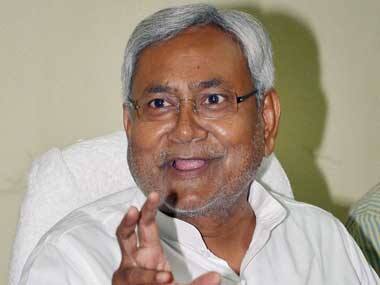Bihar Chief Minister Nitish Kumar should be a worried man. He broke up with the BJP on the issue of Narendra Modi’s rise as prime ministerial candidate, but Modi looks set to not only steal his thunder, but also give his Janata Dal (United) a drubbing in the forthcoming Lok Sabha polls in Bihar. Kumar’s woes are not with BJP alone. Even the Congress has ditched the chief minister by finally not granting special status to Bihar, which Kumar had hoped for to salvage lost ground. The Modi wave has undoubtedly caught the imagination of the electorate in Bihar, and at the crest of this wave are the upper castes.This upper caste consolidation will give BJP an overall 38 percent voteshare - well ahead of the JD(U) with 20 percent and Congress 13 percent and RJD’s 12 percent. The Lokniti-CNN-IBN National Election Tracker polls conducted in January and February 2014 discovered a massive 76 percent preference among upper caste respondents for the BJP in comparison to JDU’s 11 percent. Lalu Yadav’s RJD got a minuscule 3 percent support while the Congress the support of 9 percent from this caste. [caption id=“attachment_1420673” align=“alignleft” width=“380”]
 Bihar Chief Minister Nitish Kumar. PTI[/caption] The sample size of the survey in January was 1,317 and in February 1,316. This survey was conducted before Ram Vilas Paswan’s Lok Janshakti Party joined hands with the BJP to become a part of the NDA. This move would strengthen the BJP even further as Paswan is likely to be instrumental in reaching out to the most backward class. The study showed that even prior to the alliance the BJP was making inroads into the Yadav voter base of the RJD with 28 percent willing to vote for the party. The RJD leads the table with 38 percent of the Yadav vote, but after the BJP-LJP alliance this may not be enough. Support for JD(U) from the Yadav voter base is completely unenthusiastic with only 8 percent support. The only caste group in which Kumar has an edge is the Kurmi-Koeri community, but even here the BJP is closing in with 36 percent. Out of the 40 Lok Sabha seats, the survey, which had covered 24 constituencies, found the BJP surging ahead of others with 48 percent support even in the other OBC category. The JD(U) is below half that percentage with 23 percent. As per the survey, 27 percent of the Scheduled Castes preferred to go with the BJP while JD(U) got the green signal from 24 percent. The biggest dampener for the JD(U) has come from the Muslim community - which was the main reason for NItish jettisoning the BJP alliance. The party gets the support of 22 percent of respondents from the community. While this is well ahead of the BJP’s 11 percent, the alliance between the RJD and the Congress can spoil its advantage. The Congress has 30 percent of the Muslim vote, while the RJD has 10 percent. With a combined strength 40 percent already, the alliance is way ahead of JD(U). Kumar’s hard stand against Modi as NDA’s prime ministerial candidate now threatens to shake the very base of the JD(U) in Bihar. Although Kumar accuses Modi of being anti-minority, it is clear that he gambit is not working. The JD(U) has now formally joined an 11-party alliance with the Left leading the pack but this looks more like a face saver for Kumar who is now no longer a threat to Modi.
Bihar Chief Minister Nitish Kumar. PTI[/caption] The sample size of the survey in January was 1,317 and in February 1,316. This survey was conducted before Ram Vilas Paswan’s Lok Janshakti Party joined hands with the BJP to become a part of the NDA. This move would strengthen the BJP even further as Paswan is likely to be instrumental in reaching out to the most backward class. The study showed that even prior to the alliance the BJP was making inroads into the Yadav voter base of the RJD with 28 percent willing to vote for the party. The RJD leads the table with 38 percent of the Yadav vote, but after the BJP-LJP alliance this may not be enough. Support for JD(U) from the Yadav voter base is completely unenthusiastic with only 8 percent support. The only caste group in which Kumar has an edge is the Kurmi-Koeri community, but even here the BJP is closing in with 36 percent. Out of the 40 Lok Sabha seats, the survey, which had covered 24 constituencies, found the BJP surging ahead of others with 48 percent support even in the other OBC category. The JD(U) is below half that percentage with 23 percent. As per the survey, 27 percent of the Scheduled Castes preferred to go with the BJP while JD(U) got the green signal from 24 percent. The biggest dampener for the JD(U) has come from the Muslim community - which was the main reason for NItish jettisoning the BJP alliance. The party gets the support of 22 percent of respondents from the community. While this is well ahead of the BJP’s 11 percent, the alliance between the RJD and the Congress can spoil its advantage. The Congress has 30 percent of the Muslim vote, while the RJD has 10 percent. With a combined strength 40 percent already, the alliance is way ahead of JD(U). Kumar’s hard stand against Modi as NDA’s prime ministerial candidate now threatens to shake the very base of the JD(U) in Bihar. Although Kumar accuses Modi of being anti-minority, it is clear that he gambit is not working. The JD(U) has now formally joined an 11-party alliance with the Left leading the pack but this looks more like a face saver for Kumar who is now no longer a threat to Modi.
Election Tracker: Bihar upper castes back BJP, Nitish sliding badly
FP Politics
• March 5, 2014, 20:29:55 IST
The biggest dampener for the JDU has come from the Muslim community.
Advertisement
)
End of Article